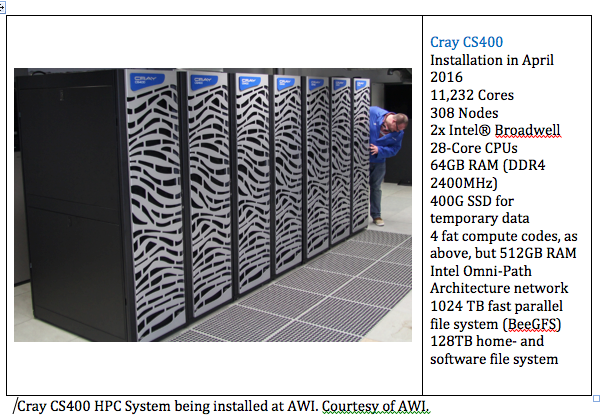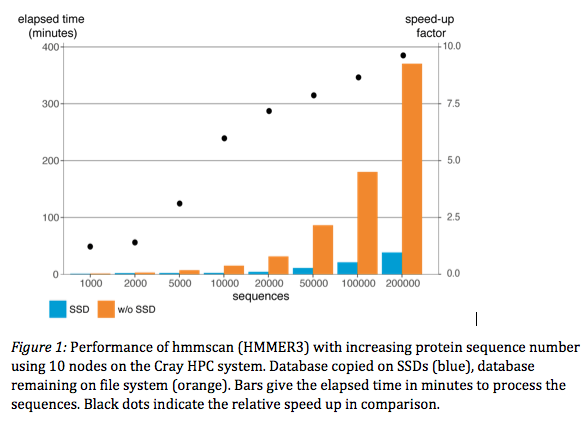The Alfred Wegener Institute, Helmholtz Centre for Polar and Marine Research (AWI), headquartered in Bremerhaven, Germany, is one of the country’s premier research institutes within the Helmholtz Association of German Research Centres, and is an internationally respected center of expertise for polar and marine research. In November 2015, AWI awarded Cray a contract to install a cluster supercomputer that would help the institute accelerate time to discovery. Now the effort is starting to pay off.
The new Cray CS400 system, nicknamed “Ollie” by AWI staff was installed in April 2016 and is being phased in for use by researchers across AWI. Ollie made it into the Top500 in June (365) and most recently in November (473). The system uses the Intel Xeon processor E5-2600 v4 (Broadwell) as well as Intel’s Omni-Path Architecture (OPA) fabric. The file systems chosen was BeeGFS (formerly FhGFS) parallel cluster file system to spread user data across multiple servers to improve performance and capacity scaling.
AWI now uses its new supercomputer to run advanced research applications related to climate and environmental studies, including global circulations models, regional atmospheric models, glaciology studies and other computing-intensive, numerical simulations such as bioinformatics protein simulations.
 “We have just started running on the Cray HPC system and have ported the main ice flow models and are starting to do Paleo ice sheet simulations on it,” said Thomas Kleiner whose glaciology research contributes to the understanding of ice sheet dynamics in the earth system and the impact of climate change. “The new system is much larger and allows us to run more detailed simulations such as simulations of Antarctica at 5km resolutions which was not possible on our older systems. It also allows us to do many simulations at the same time which helps in our research.”
“We have just started running on the Cray HPC system and have ported the main ice flow models and are starting to do Paleo ice sheet simulations on it,” said Thomas Kleiner whose glaciology research contributes to the understanding of ice sheet dynamics in the earth system and the impact of climate change. “The new system is much larger and allows us to run more detailed simulations such as simulations of Antarctica at 5km resolutions which was not possible on our older systems. It also allows us to do many simulations at the same time which helps in our research.”
“However, we also want to run simulations further back in time which is very important for climate change modeling at AWI. Compared to other components in the earth system (e.g. atmosphere or ocean), ice sheet models are relatively inexpensive in terms of computational recourses if they run for only a few thousands years, but ice sheets have a long memory of the past climate and therefore models need to be run over very long time scales (several glacial cycles).
“Running a 1,000 year simulation of Antarctica at a 10km resolution (573 x 489 x 101 grid nodes) for climate and glacier research requires 114 CPU hours on the Cray CS400 system. However, we need a resolution of 5km to get adequate detail and also need to run multiple simulations with varying parameters for model uncertainty estimates. What we currently have to do is run simulations at a coarser resolution for many thousands of years until around 10,000 years before the present time and then run simulations at 5km resolution, where the 5km setup (1145 x 977 x 201 grid nodes) already requires 420 CPU hours per 100 years. Every model improvement in terms of considered physics requires a complete recalibration of the model to match observations (although very sparse). The parameter space is huge and needs to be investigated carefully.
“We have relevant small-scale (less than a km) processes that are controlling ice sheet internal dynamics, and on the other side global atmospheric and ocean models that deliver climatic boundary conditions to the ice sheet on course grids but require very short time steps (hours to seconds). Thus, HPC systems of the future are needed to allow us to bridge the gap between the different scales (spatially and temporally) in fully coupled Earth system models including ice sheets.”
Bioinformatics Research
In 2004, AWI established a bioinformatics group to provide services to projects requiring bioinformatics and data analysis background. This group participates in data analyses in diverse projects including phylogenetics, phylogenomics, population genetics, RNA-Seq and metatranscriptomics.
Lars Harms, a bioinformatics researcher at AWI, a new user to HPC systems, is using the Cray system to speed up metatranscriptomics research and in some cases to enable the analysis at all. “Our metatranscriptomics research, helps to analyze the functional diversity and the state of organism communities in their taxonomic composition with response patterns to environmental change, to gradients, or ecological dynamics. Processing the associated large datasets on the Cray HPC system help to speed up otherwise time-consuming tasks. Furthermore, the multi-purpose concept of the AWI Cray system including some high-memory nodes is a big advantage for our research enabling us to assemble large-scale metatranscriptomes that is not possible on the existing small-scale servers due to lack of memory.”
Harms is also performing functional annotations using BLAST and HMMER code on the Cray CS400 system. “BLAST and HMMER are typically very time consuming to run. We are using the Cray system to process these tasks in a highly parallel manner which provides a huge speed up compared to our existing platforms.” Harms found a way to speed up analyzing large datasets of protein sequences using HMMER3 even further by copying the entire hmm-database onto solid state drives (SSDs) attached directly to the system nodes. This resulted in a huge speed up due to the faster data transfer rates with the SSDs in comparison to the file system of the Cray system (Figure 1).
One challenge that Harms still faces is the need to optimize software. He said, “Much of the existing software code and tools were developed to work on a single server and need to be optimized to take advantage of parallel processing capabilities of modern processors and HPC systems.”
Given the high cost of energy in Europe, maximizing energy efficiency is a top AWS priority. Malte Thoma, AWI system administrator, emphasized that energy efficiency was a major consideration when selecting a new HPC system. The Cray CS400 is an air cooled system that can control energy consumption on a per job level by allowing users and administrators to set the maximum frequency of the processor. This is done by using a cpu frequency setting in the slurm.epilog and slurm.prolog files as well as an AWI written bash-script tool which reduces maximum performance if the temperature in the room exceeds specific limits. The CS400 system provides the ability to set a general power limit for all or a fraction of nodes to conserve energy using features of the Intel Node Manager (server firmware that provides fine-grained power control).
When the Cray CS400 system is running each node and CPU, it consumes approximately 150KW of power. If the system is idle and CPUs are in HPC performance mode, it consumes 100KW. If all nodes are switched into the power save mode and the computer is idle, energy usage goes down to 55 KW—which is a reduction of almost a third in energy usage. The system can also switch between a performance mode and a power save mode. When a user starts a job, the nodes are put into performance mode but automatically switch back to power save mode when the job finishes.
Unique Modeling and System Profiling Tools
AWI scientists develop software systems, tools or libraries to support AWI staff on their individual research. The researchers, system administrator and IT team use Cray and Intel compilers as well as other tools in optimizing code. There are a number of existing AWI projects such as FESOM, MITgcm and MPI-ESM running on other platforms which are not yet run on the Cray system. The team is also performing benchmarking or profiling work on MPI or OpenMP modifying code to improve parallelization and vectorization.
According to Dr. Natalja Rakowsky, “A major optimization was performed when the sea-ice-ocean-model FESOM was redesigned switching from finite elements to finite volumes. The data structure was improved considerably. Both codes operate on a grid that is unstructured-triangular in the horizontal, and consists of layers in 3D (Z coordinates). FESOM collects the variables along the horizontal first, layer by layer. This results in indirect addressing in all loops, and in a lot of cache misses, because many computations are performed along the vertical. FESOM2 has the vertical as the first dimension, allowing direct addressing along the inner loop and often vectorization becomes possible. Cache misses remain an issue in all 2D (horizontal) computations. Here, we found a way to renumber the grid nodes to reduce the number of cache misses, see http://epic.awi.de/30632/1/IMUM2011_SFC_Rakowskyetal.pdf (the code presented here, TsunAWI, can be regarded as a simplified, 2D-only branch of FESOM).”
Other optimizations in preparation are:
- reduce load inbalancing by a better domain decomposition (getting a high quality equal distribution of 2D and 3D nodes is not easy, and sea ice is not even taken into account yet)
- asynchronous MPI
- check major loops for vectorization, avoid some divisions (replace by precomputed inverse)
- from serial to parallel I/O
The glaciology, bioinformatics and other research at AWI continue to generate huge amounts of data that will take advantage of the HPC resources. “For our research, we must find ways to process all of this data. Supercomputers can help us solve the issue of processing more data quickly, allowing us to do research that was not possible before,” states Harms.
Author Bio:
Linda Barney is the founder and owner of Barney and Associates, a technical/marketing writing, training and web design firm in Beaverton, OR.






























































